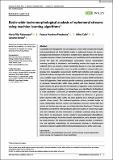Por favor, use este identificador para citar o enlazar a este item:
http://hdl.handle.net/10261/257795COMPARTIR / EXPORTAR:
 SHARE SHARE
 CORE
BASE CORE
BASE
|
|
| Visualizar otros formatos: MARC | Dublin Core | RDF | ORE | MODS | METS | DIDL | DATACITE | |

| Título: | Basin-wide hydromorphological analysis of ephemeral streamsusing machine learning algorithms |
Autor: | Rabanaque, María Pilar CSIC ORCID; Martínez-Fernández, Vanesa CSIC ORCID CVN; Calle, Mikel CSIC ORCID ; Benito, Gerardo CSIC ORCID | Palabras clave: | Ephemeral rivers Geomorphological assessment Machine learning Network segmentation Remote sensing River management Stream classification Tribute |
Fecha de publicación: | 20-ene-2022 | Editor: | John Wiley & Sons | Citación: | Earth Surface Processes and Landforms 47(1): 328-344 (2022) | Resumen: | Sustainable river management now encompasses a much wider concept that includes hydromorphological and fluvial habitat studies. In ephemeral streams, the geomorphological characterization of channels is complex due to episodic flows and riparian vegetation dynamics. Stream channel survey and classification at the watershed scale provide the basis for geomorphological conservation, process interpretation, assessing sensitivity to disturbance, and identifying reaches that supply and store sediment. Here, we present a stream classification based on a two-step approach: (1) automatic river segmentation based on spatial variability in channel/valley morphology from topographic measurements (LiDAR, light, detection and ranging), and (2) fluvial landform and vegetation density mapping derived from multispectral opensource satellite images (Sentinel-2) using support vector machine (SVM) and Random Forest (RF) algorithms. These analyses provide continuous, quantitative spatial values of geometric (channel/valley width, slope gradient, and route distance), landform (active channel and gravel bars with five densities of vegetation cover), and hydraulic (specific stream power) variables. Four stream types were identified in the Rambla de la Viuda catchment (1500 km2), an ephemeral gravel-bed river in eastern Spain. The spatial distribution of channel types is explained by differences in geometry (active channel width, valley width, and slope gradient) and a hydraulic parameter (specific stream power). The landforms/vegetation patterns provided insight on causal relationships between erosion and deposition processes during high flow periods and the time since the most recent large disruptive flood event. Channel type distribution provided first-order predictions about the location of reaches that supply and store sediment and thus information on sediment continuity along the river. Dam effects on downstream reaches resulted in geomorphological disequilibrium, producing narrowing of the active channel, slope reduction, and a decrease of gravel bar areal extension. The proposed catchment scale analysis provides a comprehensive and replicable methodology for environmental planning in Mediterranean ephemeral streams to guide further hydromorphological surveys at the reach scale. | Versión del editor: | https://onlinelibrary.wiley.com/doi/10.1002/esp.5250?af=R | URI: | http://hdl.handle.net/10261/257795 | DOI: | 10.1002/esp.5250 | ISSN: | 0197-9337 |
| Aparece en las colecciones: | (MNCN) Artículos |
Ficheros en este ítem:
| Fichero | Descripción | Tamaño | Formato | |
|---|---|---|---|---|
| Benito_G_Basin_wide.pdf | Artículo principal | 4,62 MB | Adobe PDF |  Visualizar/Abrir |
CORE Recommender
SCOPUSTM
Citations
16
checked on 18-abr-2024
WEB OF SCIENCETM
Citations
14
checked on 26-feb-2024
Page view(s)
61
checked on 21-abr-2024
Download(s)
119
checked on 21-abr-2024
Google ScholarTM
Check
Altmetric
Altmetric
Este item está licenciado bajo una Licencia Creative Commons

